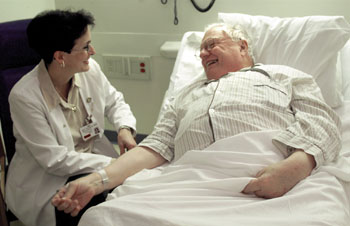
Gail Thompson, R.N., visits patient Julian Gibbs in the hospital last week. Thompson, one of the nurses at the Dayani Center, led the code team that shocked Gibbs back after an arrest during a cardiac rehabilitation workout. (photo by Dana Johnson)
Emeritus professor saved by code-trained Dayani staff
There must have been a stream of sunshine beaming through the roof of the Dayani Center Jan. 15 at about 2:30 p.m., shining onto the stationary bike Julian Gibbs peddled as if signaling divine intervention, or maybe just highlighting a lucky break.
Gibbs, professor emeritus of Radiology just six months into retirement, was working up a sweat and watching a college basketball game on TV. At the end of the workout, he started to get off the equipment and went into full cardiac arrest.
“The next thing I remember I was being loaded on a stretcher and into an ambulance to be brought over here,” Gibbs said two days after the incident from his hospital room.
His recovery “is really nothing short of miraculous,” said Les Wooldridge, who trains VUMC staff in advanced life support as manager of the VUMC resuscitation program.
The chances of surviving a full cardiac arrest decrease by 10 percent for each minute that passes, Wooldridge said. Within four to six minutes of onset, brain damage begins.
Gibbs’ heart had been giving him trouble. When it went into ventricular fibrillation, there couldn’t have been a better place or time for it to happen.
“If Mr. Gibbs had been anywhere else, or if the Dayani Center staff had not been so quick to respond, Mr. Gibbs certainly would have had brain damage, and he might have died,” Wooldridge said.
When exercise specialist Laura White saw Gibbs slump over his bike, she yelled to cardiac rehab manager Gail Thompson, R.N. In less than a minute, Gibbs was hooked up to an AED, an automatic external defibrillator, the hand-held heart charger that talks a rescuer through resuscitation. Within another 45 seconds Gibbs received his first jolt of joules (a measure of electricity). It would take five more shocks over the next seven minutes to shudder his heart into a normal rhythm.
Emily Gibbs, Julian’s wife, was walking the Dayani Center track when her husband collapsed.
“It was a fantastic experience that 14 people (including other Dayani staff who responded to Thompson’s call for a code) responded so quickly. Each staff person had a job to do and they did it,” she said.
“It’s very clear,” Gibbs said. “If I had been anywhere else in the world I would not be alive now.”
The Dayani Center has had an AED for about five years. Every staff member, from the medical director Dr. Andres Digenio to the administrative staff, has been trained to use the device, and everyone is trained in CPR. At least once a month, Thompson surprises the staff with “mock codes” drills that call to action everyone in the center to either respond to a dummy-patient or to assist others in the facility during the faux emergency.
“We have to be prepared because of the (cardiac and pulmonary rehab) patients we have here,” said Thompson. “It’s so important for people here to feel comfortable if there’s an emergency. The more you learn, the more you teach, the more you do, the better prepared you’ll be.”
The staff’s response was superb, especially since the Dayani Center is a fitness facility, not a cardiac care unit, said Dr. Andres Digenio, who was second on the scene and monitored Gibbs’ airway while Thompson attached a heart monitor and Jay Groves, Dayani administrative director, ran the AED. Gibb’s quick resuscitation, he said, is due to Thompson’s drills.
Gibbs was a Dayani regular from way back, starting his exercise program with Groves in 1982, before Dayani was in its current building. He had been through formal rehab programs following a bypass operation in 1998 and following a September diagnosis of chronic obstructive pulmonary disease. But like many other Dayani faithful, he was a satisfied customer and continued a non-structured workout at the center.
Two weeks before his cardiac arrest, Gibbs collapsed, light-headed, while walking into Memorial Gymnasium for the Vanderbilt-Ole Miss basketball game. A workup concluded that he had an arrhythmia. After his cardiac arrest at the Dayani Center, doctors installed an implantable cardio-defibrillator in Gibbs’ chest to help prevent other arrests.
A hospital isn’t where Gibbs planned to spend his retirement. There’s travelling to do. Now, he says, he has the staff at the Dayani Center to thank for giving him a chance to get on the road. “Their actions saved my life,” he said.













